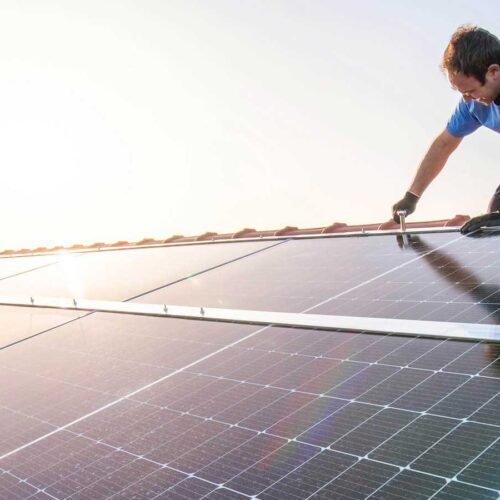Aerial shot of blue-coloured lithium mining pools Silver Peak Lithium Mine in Nevada. Shot in USA.

How the Inflation Reduction Act Will Spur a Revolution in EV Battery Supply Chains
The IRA steps up the push for a made-in-the-USA supply chain for critical minerals.
The landmark Inflation Reduction Act (IRA) was a huge victory for climate and communities. And like most victories — legislative or otherwise — it came about through assembling a collection of smaller interventions. One of these, the electric vehicle tax credit, has drawn concern from an unlikely source: automakers.
Worth tens of billions of dollars, the tax credit only applies to vehicles that meet certain strict criteria. Eligibility is contingent on 40 percent of an EV’s battery components (by value) being extracted or processed in the United States, or in one of 20 free trade partner nations. This requirement begins in 2024 and gradually ratchets up to an eye-watering 80 percent in 2027.
Across industries, these numbers sent heads spinning. The reason: today’s global mineral supply chain is based almost entirely outside of the United States and its free trade bloc. In order to meet this goal, critical mineral supply chains will require a miniature revolution.
How the United States Fell Behind
Batteries are an essential part of the clean energy transition. The International Energy Agency estimates that demand for battery minerals, including aluminum, copper, cobalt, and lithium, will grow sevenfold by 2030. Domestic mineral supply chains will need to catch up. The United States alone will need 500,000 metric tons per year of unrefined lithium by 2034 just to power EVs, but it currently accounts for only 1 percent of global lithium production.
In the same period, a rapidly industrializing China has created a near-monopoly on many of these minerals. Although it mines around 1 percent of the world’s cobalt, China is responsible for refining and exporting roughly 80 percent of the world’s supply. The story for lithium is similar. Although most of the world’s lithium is mined in South America and Australia, China is the largest lithium refiner globally and ranks among the top lithium producers in the world, outproducing the United States by more than a factor of 15 in 2020.
To catch up, the United States will need to invest $175 billion for battery production in the next three years. At the same time, it will need to increase its recycling capacity and improve circularity in the battery supply chain. The domestic mining industry will need significant incentives to get there. Fortunately, the IRA’s production tax credit will speed this process along.
The IRA sets ambitious traceability goals through its critical mineral and battery requirements, with the intention of securing US energy security and spurring domestic industry. But critical minerals are only sustainable (and affordable) if they are a) produced ethically, b) recycled as much as possible, and c) used efficiently. Those three qualities haven’t always been the hallmark of American industry, but there has never been a better time to shift those paradigms.
How Do We Get There?
Building domestic industries in response to federal investments is not new to the United States — just think of the New Deal and World War II. But over the past few decades, the nation has been slow to mobilize the clean energy economy. Achieving the speed and scale of deployment required to rapidly drive down emissions will take significant innovation to overcome existing points of friction. Industry players should be on the lookout for three opportunities.
- Don’t Wait — Differentiate!
The IRA sets up the right incentive system for the market to align with responsible production, with public procurement leading the way. But scaling these early successes requires building market platforms that prioritize responsible production. That requires sending robust price signals that distinguish sustainable commodities from the rest. Already, businesses like Apple and Anheuser-Busch InBev are inking deals with responsible metal producers. The next step is to give these products a separate niche in commodity markets, where they can trade at a premium, akin to Fairtrade coffee.
How will the IRA help this advance? In addition to the funding in the 2021 Bipartisan Infrastructure Law, the IRA provides a boost for the Federal Buy Clean Initiative with $4.5 billion dedicated to promoting the use of low-carbon construction materials. The new law will facilitate this process through a $250 million investment to set up the Environmental Product Declaration (EPD) Assistance Program, along with a national eco-label for low-carbon products.
- Pushing the Boundaries of Traceability
Traceability remains a distant exception in this industry. Most companies simply don’t know where their minerals come from.
Technology will be an indispensable partner in changing this status quo. Transitioning from outmoded paper trails to centralized or distributed ledgers will allow user-friendly, low-cost, interoperable, and auditable proofs of mineral supply chains. We need a system that goes beyond business-to-business agreements to become the status quo in the industry.
We wait for more details from the administration on how the policies in the IRA will be implemented with bated breath. How will companies demonstrate that their mineral supply chains lead back to Nevada and not to China? We also expect that the requirements will progressively extend beyond provenance, so that commodities can be differentiated based on a more holistic set of characteristics, such as emissions intensity, water use, and human rights impacts. At RMI, we are mapping the challenges for the industry and taking action to engage.
As regulation in the United States grows more robust, domestic companies should look at European companies, who are designing due diligence and digital systems for global verification. If multinationals are already doing this to comply with European regulation, companies in the United States should expect to deliver similar levels of responsible sourcing in due course.
- Reinventing Extraction for the 21st Century
Globally, mining firms routinely fail to prioritize social license to operate until it’s too late. Social and environmental justice concerns in the United States have led to challenges in producing the core materials required for the clean energy transition. Planned mines such as the Thacker Pass have been abandoned, largely due to local opposition, leaving the United States with just one operational lithium mine.
Opposition to new resource development is understandable. Hard rock mining can create local air pollution, poison watersheds, and damage nearby communities, and hundreds of new mines will be required globally to fuel the material demands of clean technologies. The brutal legacy of commodity booms casts a long shadow across the United States. Going forward, high-road practices are essential for public support.
Fortunately, the industry has frameworks and precedents for how to improve mining practices to minimize impacts while maximizing benefits. Australia and Canada have grappled with ways to responsibly engage Indigenous communities around resource development. Sierra Leone recently passed a new mining law that aims to improve provisions for the socioeconomic benefit of the country.
The United States should set a new social contract for extraction, with a goal of setting the international standards for minimizing environmental harms and ensuring that benefits are distributed to communities while simultaneously accelerating national clean energy supply chains. It’s not just a matter of fairness — it will also ensure a favorable social environment to allow the industry to scale.
How the Private Sector Can Help
It’s time for manufacturers and producers to follow Congress’s lead. Manufacturers have the power to transmit demand signals up the supply chain and incentivize a shift toward responsibly produced commodities sourced domestically or from trustworthy partners abroad. The IRA sends a strong message that many consumers have already known for decades: commodities look alike, but their provenance matters.
A sweeping, just energy transition requires a strong foundation of integrity that goes to the roots of the material economy. Aligning environmental justice with the energy transition isn’t just a convenience — it’s an absolute necessity.

